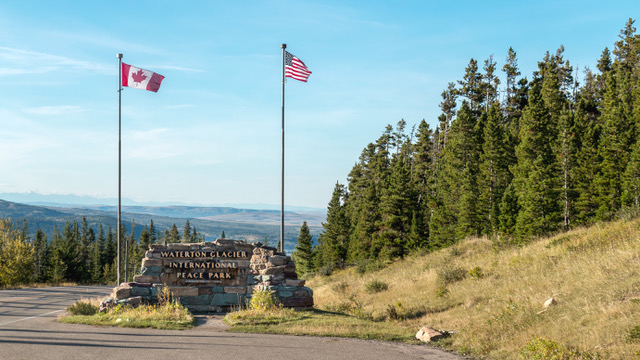

It was devised a year earlier, on July 4, 1931, during a fellowship gathering of 100 Rotarians at the Prince of Wales hotel in Waterton. Seven Rotary clubs from either side of the Alberta/Montana border decided to recognize the unique relationship of their neighbouring districts by creating an international peace park. As “people of action,” they successfully lobbied the Canadian and American governments in record time. The necessary legislation passed within a year. Two thousand people attended the dedication ceremony of the Waterton-Glacier International Peace Park on June 18, 1932. Imagine the sight of hundreds of Rotarians standing on opposite sides of a symbolic border shaking hands in a pledge of peace! |
| Three years later, in 1935, the Waterton-Glacier International Peace Park Association was established Since then, it has held annual meetings in either Waterton or Glacier National Park. In 1995, the peace park became a UNESCO World Heritage Site. Along with a focus on promoting awareness and care for the outstanding natural environment in the adjoining parks (which include unique animal, plant, alpine and glacial features), the association is now taking a more active role to promote positive peace education. It recently passed a “peace pledge” which reads in part, “we will not take up arms against each other.” It also established five action teams. |
|
The Peace Action Team is focused on peacebuilding activities within Rotary Districts D5080, 5390, 5360, 5370. At the Waterton-Glacier annual assembly, it announced a project to celebrate the 100th anniversary of the peace park in 2032 by planting 100 peace poles in the four Rotary districts.
The Branding and Promotion Action Team is engaged in increasing public awareness of the association.
The Indigenous Engagement Action Team is collaborating with neighbouring Indigenous communities.
The Peace Centers Action Team is exploring options to establish a Peace Centre for gatherings and workshops at a property under consideration in Glacier on Lake McDonald and at a garden in the Waterton townsite.
The Outreach and Extension Action Team is involved with a separate association dedicated to forming a peace park across the borders of India and Pakistan. It is also intent on gaining recognition as a Rotary Fellowship related to peace parks.
The Waterton-Glacier International Peace Park Association is a superb and enduring example of Rotary International’s core mission to provide service, promote integrity and advance world understanding, goodwill, and peace.


